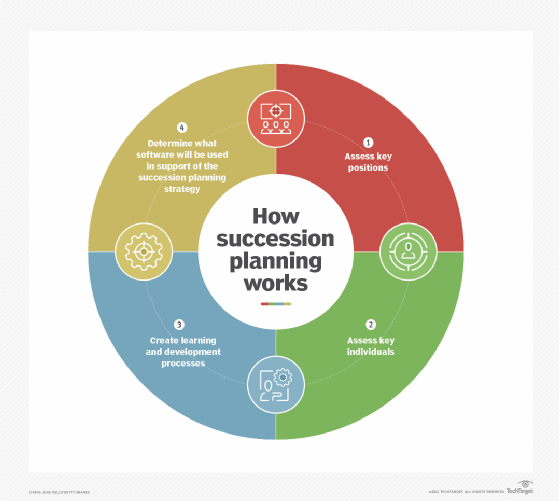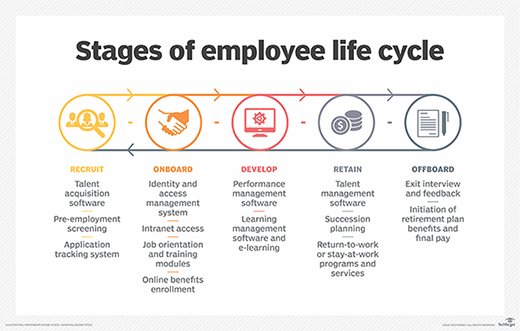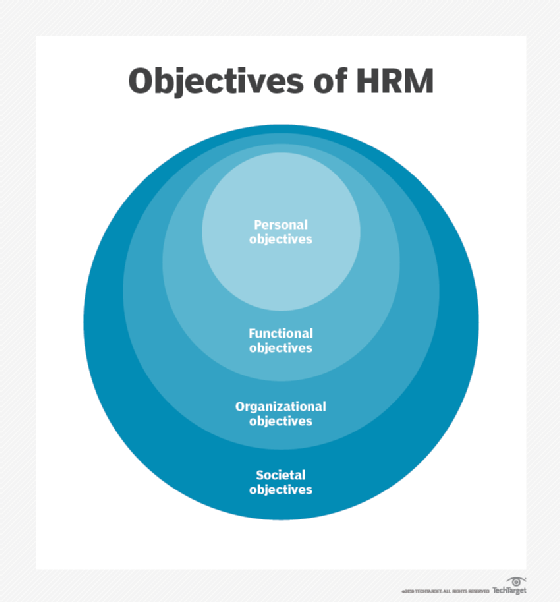What is succession planning?
Succession planning is the strategic process of identifying and developing internal candidates to fill key organizational roles to ensure business continuity and the availability of effective leadership in the face of role transitions, departures or unforeseen events.
Succession planning is relevant to all companies, large or small, for-profit or nonprofit. In fact, management experts suggest it should be on the radar of every organization because it can mitigate disruptions when employees leave or are promoted.
Effective succession planning assesses potential staffing needs and creates long-term goals and strategies, including leadership development, to manage those gaps. Furthermore, the plan helps ensure that the employees chosen to fill critical roles have the necessary skills, experience and knowledge to do so.
Organizations can create both emergency and long-term succession plans. An emergency plan can be designed to be implemented in the event of sudden or unexpected changes to critical and/or high-level staff. A long-term plan takes a long-haul approach and helps businesses proactively plan for replacements systematically.
The strategic importance of succession planning
In a narrow context, succession planning refers to being ready to replace the company chief executive officer (CEO) or executive director. In the event that one of these high positions suddenly becomes vacant because of business issues, resignation, illness or death, a succession plan ensures that there is already a method in place to fill that role. When used in a broader sense, the term can refer to replacing other members of the C-suite, key leaders or board members, if necessary.
The need to replace these important staff members might arise for various reasons:
- Departure from the company to explore new opportunities.
- Retirement.
- Death, whether unexpectedly or following an illness.
- Inability to continue doing their job due to other commitments or challenges, such as illness, personal issues, etc.
An organization might want a succession plan to retain internal company knowledge, identify skills gap training needs and invest in good employees. The process helps identify employees with the right skills and talent to fill the vacant position. In addition, these internal candidates are cross-trained to ensure that they can seamlessly slide into the new position, thus ensuring minimal disruption to the company's operations and strategic plans if needed.
Succession planning ensures a business can continue running smoothly after an important role becomes vacant. It gives an organization time to prepare candidates with high potential to fill that role. The planning process is meant to create a talent pipeline of successors that will keep the organization running with little to no interruption.
During this time, potential candidates are evaluated, strengths and knowledge gaps are identified, and the selected candidate receives training in needed areas. In most companies, the board of directors plays a vital role in ensuring that succession planning occurs.
What are the benefits of succession planning?
When an employee in a critical or strategic position leaves a company, it usually has a ripple effect. At the very least, it can disrupt processes and workflows, affecting productivity and output. It can also lead to the following challenges:
- Knowledge gaps.
- Weakened internal controls, leading to poor accountability and transparency, and in some cases, mismanagement and errors.
- Uncertainties about the firm's future direction.
- Increased workload on the remaining employees.
- Downturn in employee morale.
- Customer churn.
- Increased employee turnover.
- Negative effect on stock prices.
The hole created when a key employee leaves their position can be profound, even at lower levels. Replacing employees can be difficult, especially in industries with noted talent shortages and skills gaps.
It can be a lengthy process to onboard a replacement employee and get them to full productivity. A lack of planning can especially damage smaller and family businesses, which often don't have surplus candidates to choose from and are wary of assigning key roles to personnel from outside the family. A well-thought-out succession plan can mitigate these issues.
Companies that create, regularly evaluate and maintain updated succession plans can expect to garner these benefits:
- Succession planning helps ensure business continuity, even if critical employees leave the organization. Other skilled employees can quickly fill needed roles, enabling business operations to continue uninterrupted and successfully.
- Management can monitor valuable employees and ensure that they are given the training to seamlessly take over a new role when needed.
- Supervisors and other senior staff can mentor employees, thus transferring their expertise and ensuring a ready pipeline of available candidates to fill critical positions in the future.
- Early and proactive succession planning helps save both time and cost because the time needed to find an employee's replacement after the employee has already left will cost the firm time and money -- in addition to hampering the productivity and efficiency of other employees if a succession plan isn't in place.
- With many senior executives from the baby boomer generation now retiring or scheduled to retire in the coming few years, succession planning helps ensure there are employees with the right skill sets to replace these executives.
- In a candidate-driven market characterized by a scarcity of talent for roles, candidates have more jobs to choose from. That means companies compete for the same candidates. This typically makes it difficult to attract, hire and retain desired candidates. Choosing internal employees using succession planning to fill vacant critical roles helps alleviate this problem.
- Succession planning helps an organization develop a reputation as a desirable talent destination. A firm known for its succession planning efforts demonstrates that it is committed to employee development and career growth. This can help to attract talented, skilled individuals and reduce the human resources (HR) cost and effort involved in recruitment and hiring.
- Succession planning has a positive effect on existing workers. It makes them feel valued and "seen" for future positions. It enables firms to communicate their commitment to employees' career development and growth, boosting employee engagement and workplace satisfaction.
- It helps to align HR and the vision for an organization and supports HR and managers in creating and supporting proactive programs for employee engagement, learning and career progression.
- Succession planning can help companies to meet their DEI -- diversity, equity and inclusion -- goals. Planners can identify suitable candidates from diverse backgrounds, thus maintaining equity and ensuring that the right people are available to fill key roles as needed.
Read a more detailed analysis of the benefits of succession planning.
How does the succession planning process work?
Depending on the size of the organization, its staff makeup, and business goals and objectives, the succession planning process can vary widely. However, the fundamental steps usually include the following:
- Identify significant challenges that might affect the business in the next few years; it's advisable to narrow this down to a specific period, such as one to five years).
- Assess key positions and individuals that support business continuity now and will be expected to do so in the face of future challenges.
- Decide which positions to focus on to help identify their potential successors.
- Identify the skills, competencies and knowledge successors must have to successfully fill critical roles.
- Identify high-potential employees for the key positions.
- Assess the extent to which internal candidates can fill roles, likely with development; employees who will be familiar with company culture and processes; and which roles HR should look externally for to find the right talent pool.
- Create learning and professional development processes that support the succession strategy, especially experiential development such as job shadowing and cross-functional moves.
- Capture and document key individuals' knowledge before they leave the organization. Add this knowledge to the successors' training plan.
- Create learning and development plans tailored to develop a wider talent pool for more expansive succession plans.
It is also crucial to gain the support of key stakeholders, including the CEO or executive director, to oversee and guide the planning effort. It's equally important to determine which HR software will be used to support the succession planning strategy and process. Successful succession planning depends on the right mix of people, processes and tools to achieve these two goals:
- Minimize the negative effect of staffing changes.
- Ensure that a pipeline of suitable candidates is readily available to step into important positions.

Best practices for succession planning
Succession plans should fit into the company's larger strategic vision, ensuring that future leaders are prepared to drive this vision forward. This alignment helps build a leadership team that is competent in operational execution, strategic thinking and long-term planning.
While the top executive is a key factor in a company's performance, taking a wider lens to the concept of succession planning is increasingly seen as critical, particularly given the current challenges associated with talent management in companies today.
Here are more succession planning best practices to follow:
- Be proactive. Prepare for unforeseen instances where a high-level executive or critical resource suddenly leaves. Early preparation is vital to ensure the organization can keep operating normally.
- Clarify the roles included in the succession plan. Clearly document the positions and the people involved in the plan. The positions included might be CEO, other C-suite positions, and additional critical, managerial or leadership roles.
- Engage stakeholders in the process. Instead of overseeing everything, HR should enable the process and provide the necessary tools. The CEO and board should oversee the process and guide to ensure a comprehensive and implementable plan.
- Don't exclusively choose the employee closest in rank to the role that needs to be filled. Other promising employees should be chosen if their skills are optimal.
- Start backward. Before training an employee to fill a specific role, define the core skills, abilities and competencies needed for that role.
- Train successors with mentors and job rotations. Supervisors and other senior staff can mentor potential successors to transfer expertise and knowledge of certain roles and experiences.
- Give regular feedback. Include evaluations of those who need to be developed further.
- Create individual development plans. With this, employees receive the specific attention needed to develop required skills. Managers should also give continual feedback.
- Have trial runs. A trial run is when a potential successor assumes some of the responsibilities of the role they are inheriting. This practice will help the chosen successor gain valuable experience and be better prepared when they take on the role in the future.
- Get insurance. In partnership firms, partners can get life insurance where the other partner is the beneficiary. Such cross-purchase agreements can help minimize the chaos that inevitably results from a partner's death and provide the funds the surviving partner needs to continue operating the business.

Succession planning for small businesses and startups
Due to a limited internal talent pool, small businesses and startups often face distinct succession planning challenges. For these entities, it's crucial to focus on external talent acquisition strategies, develop partnerships with educational institutions for talent development, and consider the broader ecosystem of mentors and industry networks to support leadership continuity.
For both kinds of firms, early succession planning is crucial. Firm owners and senior leaders must also consider these steps:
- Build a strong team with diverse skills so members can help fill in the gaps a departing employee might leave.
- Identify critical roles that must be prioritized during a transition or unexpected staffing change.
- Create a pool of internal -- or, more likely, external -- candidates to fill those roles.
- Document crucial aspects of the business, including standard operating procedures.
- Prepare potential successors with training, mentoring and timely knowledge transfer.
- Consider different scenarios to guide the planning and knowledge transfer process.
- Regularly review the plan with legal, financial and business advisors and update it as needed.
Succession planning in global and remote work environments
The COVID-19 pandemic significantly impacted succession planning, and it highlighted the need for robust strategies to address the abrupt absence of key personnel and ensure business continuity in unpredictable circumstances, such as a sudden shift from in-person to remote work.
Global and remote work environments pose unique challenges for succession planning, such as cross-border talent management and developing leaders who can lead virtual teams effectively.
To address these challenges, forward-thinking businesses use technology for virtual leadership development programs and ensure that succession plans are adaptable to accommodate the nuances of managing a geographically dispersed workforce.
Additionally, using advanced HR analytics and machine learning has become pivotal in identifying potential successors and predicting future leadership gaps in a dispersed workforce.
Tools such as SAP SuccessFactors, Oracle HCM Cloud and Workday provide sophisticated analytics capabilities. They enable organizations to assess talent potential, performance and readiness systematically, facilitating more informed succession decisions.
Different uses of the term succession planning
It's important to note that succession planning is often used narrowly to refer to the CEO or executive director, or slightly more broadly to include board members, key leaders or the C-suite.
However, extending the concept of succession planning to a broader range of employees is gaining widespread traction, especially through the use of HR software, generally, or talent management software, specifically. Succession planning might also indicate the passing of company ownership onto employees.
Sometimes, the term succession planning is synonymous with replacement planning. However, succession planning involves planning for filling critical roles when an employee leaves, whereas replacement planning refers to transferring ownership of a company to someone else.
Real-world succession planning examples
For several years before Steve Jobs stepped down as CEO of Apple in 2011, he had groomed his successor, Tim Cook, to take the top leadership role. This included Cook working a wide range of operational roles and directly with Jobs for CEO-specific experience. Cook also stepped in to lead daily operations twice when Jobs was on sick leave. Besides creating a succession plan for the top leadership role, Jobs founded Apple University in 2008 to provide a leadership curriculum based on Jobs' experiences and business savvy.
The following are other examples of companies that created succession plans and successfully put them into practice:
- Ford Motor Company.
- Microsoft.
- P&G.
- PepsiCo.
- Unilever.
- Walmart.
Some of these companies groomed existing senior employees to take over the CEO position once the existing CEO retired. Microsoft is one example, with the transition of Steve Ballmer to Satya Nadella. Other firms created succession plans to fill in other senior positions, such as Unilever with its HR director and PepsiCo with its chief financial officer.
Integration of succession planning with other HR processes
HR departments, sometimes called the human resources management (HRM) department or human capital management (HCM), are typically a key driver in succession planning. However, support from top leadership and other stakeholders is critical to success.
Succession planning is intricately linked with other HR processes, such as performance management, learning and development, and workforce planning. This integration ensures a holistic approach to talent management, where performance data feeds into succession planning, development plans are tailored to prepare successors and workforce planning informs the strategic direction of succession efforts.

For IT departments, succession planning must be an ongoing strategic priority, not an afterthought. Learn how to create an IT succession plan for key tech roles.






